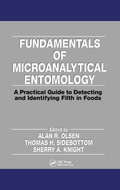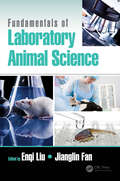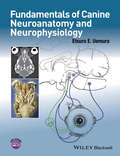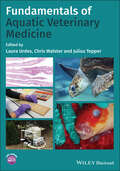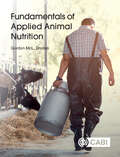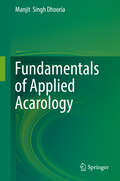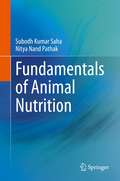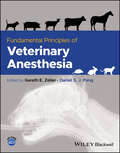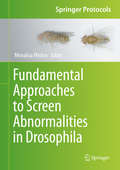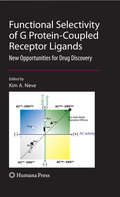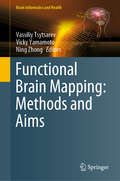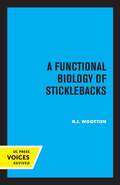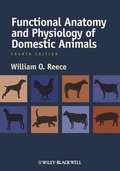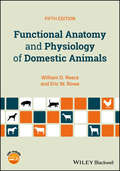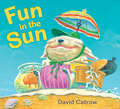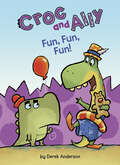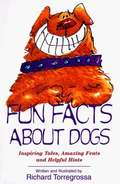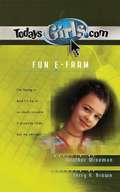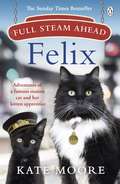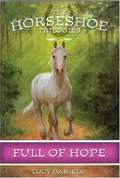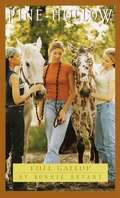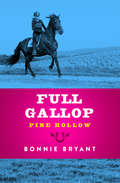- Table View
- List View
Fundamentals of Microanalytical Entomology: A Practical Guide to Detecting and Identifying Filth in Foods
by ALAN R. OLSEN; THOMAS H. SIDEBOTTOM; SHERRY A. KNIGHTThis text offers insight into the practical applications of microanalytical entomology in the laboratory and in the field of consumer protection. This is the only guide that gives an overview of the subject from initial analysis of a product to interpreting significance of final results. Complete insect illustrations throughout and an insect fragment identification discussion covers all pests that are found in foods. Micrographs illustrate a complete reference on identifying types of hair contaminants found in various foods. Chapters are written by practicing regulatory experts.
Fundamentals of Laboratory Animal Science
by Enqi Liu and Jianglin FanLaboratory animals are becoming increasingly important for biomedical research. It is said that approximately 70% of biomedical research is associated with the use of experimental animals. Laboratory animal research not only expands our knowledge of science, but also greatly improves human and animal health. The field of laboratory animal science is ever-growing and changing as new experimental techniques are developed and new animal models are created. It is essential to know not only the biological features of each laboratory animal but also how to use and care for them responsibly in order to perform high-quality experiments. Courses in beginning Laboratory Animal Science are starting to be offered in many universities throughout the world. However, a practical introductory textbook that contains state-of-the-art techniques is still lacking. Fundamentals of Laboratory Animal Science provides comprehensive information on the principles and practices of using laboratory animals for biomedical research. Each individual chapter focuses on a key sub-discipline of laboratory animal science: animal welfare and best humane care practices in the laboratory; the quality control of laboratory animals; the anatomy, physiology, and husbandry of commonly used species; the principles of creating and using animal models for studying human diseases; practical techniques used for laboratory animal experiments; experimental design; and animal experimentation management. Knowledge of this broad spectrum of concepts and skills will ensure research goes smoothly while greatly reducing animal pain and distress. Well-illustrated and thoroughly referenced, this book will serve not only as a standard textbook but also as a handy guide for veterinarians, researchers, animal care staff, administrators, and other professionals who are involved in laboratory animal science.
Fundamentals of Canine Neuroanatomy and Neurophysiology
by Etsuro E. UemuraFundamentals of Canine Neuroanatomy and Neurophysiology introduces the fundamentals of veterinary neuroanatomy and neurophysiology, demonstrating structure and function as it relates to clinical applications with a highly visual approach. * Offers a straightforward yet comprehensive introduction to structure and function of the nervous system * Demonstrates the relevance of the basic principles to the clinical setting * Illustrates concepts using line drawings, photographs, micrographs, and MRIs * Includes access to a companion website with review questions and answers and the figures from the book at www.wiley.com/go/uemura/neuroanatomy Fundamentals of Canine Neuroanatomy and Neurophysiology introduces the fundamentals of veterinary neuroanatomy and neurophysiology, demonstrating structure and function as it relates to clinical applications with a highly visual approach. * Offers a straightforward yet comprehensive introduction to structure and function of the nervous system * Demonstrates the relevance of the basic principles to the clinical setting * Illustrates concepts using line drawings, photographs, micrographs, and MRIs * Includes access to a companion website with review questions and answers and the figures from the book at www.wiley.com/go/uemura/neuroanatomy
Fundamentals of Aquatic Veterinary Medicine
by Laura Urdes Chris Walster Julius TepperFundamentals of Aquatic Veterinary Medicine Covers the competencies necessary to assure the highest quality of aquatic veterinary services Fundamentals of Aquatic Veterinary Medicine provides systematic, highly practical guidance on the treatment of aquatic mammals, amphibians, fish, and invertebrates in veterinary practice. Mapping to each of the nine core areas of the WAVMA Certified Aquatic Veterinarian (CertAqV) Program, this comprehensive clinical reference covers taxonomy, anatomy and physiology of aquatic species, water quality and life support systems, diagnostics, treatment, and prevention of aquatic diseases, and more. Designed to help readers acquire and demonstrate the necessary knowledge, skills, and experience to be competent in aquatic veterinary medicine, this authoritative guide: Focuses on “Day One” competencies outlined by the World Organization for Animal Health (OIE) Covers pathobiology and epidemiology of aquatic diseases, public health,zoonotic diseases, and seafood safety Provides up-to-date information on relevant legislation, regulations, and policies Fundamentals of Aquatic Veterinary Medicine is a must-have reference and review guide for veterinary students and practitioners interested in practicing aquatic veterinary medicine, as well as for aquatic veterinarians looking to become WAVMA certified or wanting to acquire OIE “Day One” competency.
Fundamentals of Applied Animal Nutrition
by Gordon DrydenIf you have ever wondered why animals prefer some foods and not others, how poor feeding management can cause conditions such as laminitis, rumenitis or diarrhoea, or how to construct a diet to optimise animal performance and health, then this book will introduce you to the fundamentals of animal nutrition and their practical implementation. While giving a comprehensive and practical overview of the principles that underpin the design and management of farm animal feeding systems, this book: - Covers a wide range of topics from digestive function, nutrients and feed composition, to intake, feed related disorders, grazing behaviour and management, as well as how animals influence climate change and the environment. - Contains hints, tips and practical advice on animal feeding. - Includes links to the latest data on feed composition and nutrient requirements. - Is a companion book to the author's book titled Animal Nutrition Science. With its evidence-based approach and emphasis on the practical throughout, this is a valuable textbook for undergraduate and graduate animal science students studying the feeding of farm animals. It is also an essential reference for early practitioners, veterinarians, farm managers and advisers in animal feed companies.
Fundamentals of Applied Acarology
by Manjit Singh DhooriaAcarology - the study of mites and ticks, is a subdiscipline of Zoology, and is many times considered in the field of Entomology (the study of insects). Mites and ticks are distributed throughout the world and inhabit almost every ecosystem (both terrestrial and aquatic) including grassland soils. More than 55,000 species of mites and ticks are already described. Mites and ticks directly affects humans as pests of different crops, fruit plants, vegetable crops and field crops; as parasites of human beings, veterinary animals, poultry and pets; pests of stored grains and other products; mushrooms and cheese; and as parasites of honeybees. Mite infestations are responsible for economic losses worth billions of dollars in terms of reduced crop yields and lowered quality of produce. Many species of mites serve as vectors of various plant diseases; some species of ticks cause losses through blood feeding and by transmitting many diseases among man and animals. House-dust mite allergies, and tick bite allergies are also common in many parts of the world. Present Book, "Fundamentals of Applied Acarology," is written keeping in view non-availability of any standard text dealing in different aspects of acarology at one place. Separate chapters in this book are devoted to Importance of Acarology, Historical account, acarine technology, morphology and anatomy of Acari; Feeding, Development and Reproduction. Molecular developments in relation to mites and ticks are also discussed. Role of mites and ticks in Quarantines of plants and animals; forensic/criminal investigations; and importance of accidental acarophagy are discussed in detail. Safe usage of pesticides based on their mode of action (IRAC's Groups), development of acaricide resistance and measures to mitigate it are discussed. Mite pests of fruit trees, vegetable plants, and floricultural plants; field crops; mite problems in greenhouses/polyhouses; and mite problems encountered under organic cultivation of plants; and their management through minimum usage of pesticides are emphasized. Role of different predaceous mites in controlling plant pests like thrips, aphids and scale insects is elaborately discussed. Biological control of phytophagous mites is discussed in detail. Different animal parasitic mites and ticks are discussed from veterinary and medical point of view. At the end of each chapter, many important references for further reading; and Electronic References (ER) in the form of youtube links and other weblinks are given to understand fully how these tiny creatures look like; behave, feed and reproduce; nature of damage they cause to plants and animals; and measures to mitigate them. Weblinks will stimulate interest in the readers for more information about different mites and ticks. The knowledge contained in the book may prove as best material for "General and Applied Acarology" course for graduate and post-graduate levels, teachers and researchers in entomology, pest control advisors, professional entomologists, pesticide industry managers, policy planners, and others having interest in mites and ticks.
Fundamentals of Animal Nutrition
by Subodh Kumar Saha Nitya Nand PathakThe book provides comprehensive information about the different aspects of veterinary nutrition in tropical countries.The introductory chapter discuss the importance of nutrition, feeds and feeding of balanced and optimum feeds specifically required for the sustenance of life. The second chapter, discusses briefly the history of research in animal nutrition.The book further talks about the relationship between the environment and nutrition in animals; the chemical composition of plants and animals; and the various sources of feed for animals. It provides details on the different phases of life cycle in animals, and the effect of nutrition on the performance. Various Nutrients and its importance in livestock nutritionand production has been illustrated in details. Various nutrients such as water, carbohydrate, protein, fats, vitamins, minerals etc are individually dealt in a separate chapter. The digestive system,digestion and metabolism of carbohydrates, protein and fats in ruminant and non ruminant livestock have been illustrated. A dedicated chapter fully describes the activity of enzymes which are directly involved in nutrition. Also this book deals with the harmful components of animal feed which are found mainly in the unconventional feeds. The books also provide chapters like partitioning of feed& energy and also the therapeutic and clinical nutrition which are very importantfor the under graduate & post graduate students and researchers of animal nutrition and livestock production and management. This book is useful for researchers, undergraduate and post graduate students studying veterinary sciences, animal husbandry, zoology and biochemistry.
Fundamental Principles of Veterinary Anesthesia
by Gareth E. Zeiler Daniel S. J. PangFundamental Principles of Veterinary Anesthesia Comprehensive textbook integrating physiology and anesthesia of multiple species of animals in a unique practical setting Fundamental Principles of Veterinary Anesthesia is designed specifically for veterinary students, animal health technicians and veterinarians in general practice. The first edition of Fundamental Principles of Veterinary Anesthesia covers the key principles of veterinary anesthesia, encompassing a wide range of species, including dogs, cats, horses, cattle, and pigs, and establishing links between physiology, pharmacology, and clinical practice in healthy and ill patients. This text serves as a practical guide for students to prepare themselves for clinical work in a private practice setting, and as a rich, practical resource for those in general practice. This text is ideally used as a complete curriculum aligned resource, and the companion website is designed to decrease the burden of lecturers who need to compile PowerPoint presentations and review questions. Topics covered in Fundamental Principles of Veterinary Anesthesia include: Practical approaches to the peri-anesthetic period, from patient assessment, through to preparing for, and successfully completing, an anesthetic event Anesthetic drugs available in an academic or private practice, with a focus on commonly used drugs Components of the anesthetic machine, gas flow through the machine, how vaporizers work and their functionalities Principles and techniques of patient monitoring, with a focus on commonly available devices and their applications
Fundamental Approaches to Screen Abnormalities in Drosophila (Springer Protocols Handbooks)
by Monalisa MishraThis volume includes in-depth, hands-on protocols for detecting various developmental defects in Drosophila. It provides cutting-edge methods for maintaining Drosophila under laboratory conditions to perform various experiments, and for dissecting various imaginal discs of the larvae. Further, biochemical protocols for estimating the levels of different metabolites, reactive oxygen species, and fat-sensitive pathways are discussed, and various staining and behavior techniques for fat detection are provided. The book explains how various fluorescent dyes and the comet assay can be used to identify DNA damage, and elaborates on the analysis of the eye, antennae, imaginal disc, gut and muscle damage under bright field and fluorescent microscopes. It covers the analysis of hemolymph using Giemsa staining; determining the functionality of channel proteins, eye and mechanosensory organs in adults and larvae using various behavioral assays; and metal detection and structural analysis for various tissues using SEM. In closing, it addresses the analysis of Drosophila’s eye and head via paraffin section; measurement of reactive oxygen species from various tissues via FACS; and the CRISPER technique for gene editing and analysis of micro RNA mutations.
Functional Selectivity of G Protein-Coupled Receptor Ligands
by Kim NeveFunctional selectivity refers to the ability of different ligands acting at one receptor subtype to activate multiple signaling pathways in unique combinations; that is, one drug can be an agonist at pathway A and an antagonist or partial agonist at pathway B, and another drug can have the reverse profile. Functional selectivity has profound implications for drug development, for chemical biology, and for the design of experiments to characterize receptor function. In Functional Selectivity of G Protein-Coupled Receptors expert neuroscientists and pharmacologists review the work that demonstrated the existence of functional selectivity, placed it within a theoretical framework, and provided a mechanistic basis for the phenomenon. This exciting, comprehensive, and future-oriented volume includes chapters that focus on theoretical and mechanistic aspects of functional selectivity and that cut across subfamilies of GPCRs. Additional chapters focus on subfamilies of therapeutically relevant receptors where there is considerable evidence of ligand functional selectivity. Accessible and authoritative, Functional Selectivity of G Protein-Coupled Receptors is a valuable educational tool and reference source for students and scientists interested in drug development, chemical biology, and GPCR function.
Functional Morphology of Feeding and Grooming in Crustacea
by Bruce E. Felgenhauer Anne. B Thistle L. WatlingAbetted by recent technological advances in scanning and transmission electron microscopy, as well as new preparative methods, these contributions examine crustacean anatomy, demonstrating (or at least inferring) the functions of morphological features. In addition to feeding and grooming, they also
Functional Brain Mapping: Methods and Aims (Brain Informatics and Health)
by Vassiliy Tsytsarev Vicky Yamamoto Ning ZhongThis book provides an essential overview of the broad range of functional brain imaging techniques, as well as neuroscientific methods suitable for various scientific tasks in fundamental and clinical neuroscience. It also shares information on novel methods in computational neuroscience, mathematical algorithms, image processing, and applications to neuroscience.The mammalian brain is a huge and complex network that consists of billions of neural and glial cells. Decoding how information is represented and processed by this neural network requires the ability to monitor the dynamics of large numbers of neurons at high temporal and spatial resolution over a large part of the brain. Functional brain optical imaging has seen more than thirty years of intensive development. Current light-using methods provide good sensitivity to functional changes through intrinsic contrast and are rapidly exploiting the growing availability of exogenous fluorescence probes. In addition, various types of functional brain optical imaging are now being used to reveal the brain’s microanatomy and physiology.
A Functional Biology of Sticklebacks
by R. J. WooltonThis title is part of UC Press's Voices Revived program, which commemorates University of California Press’s mission to seek out and cultivate the brightest minds and give them voice, reach, and impact. Drawing on a backlist dating to 1893, Voices Revived makes high-quality, peer-reviewed scholarship accessible once again using print-on-demand technology. This title was originally published in 1984.
Functional Anatomy and Physiology of Domestic Animals
by William O. ReeceFunctional Anatomy and Physiology of Domestic Animals, Fourth Edition provides a thorough grounding in the structure and function of animal body systems. Taking an integrated approach to the basics of anatomy and physiology, the book helps readers understand their interconnection in common domestic species. With chapters logically arranged by system, Functional Anatomy and Physiology of Domestic Animals offers students in pre-veterinary or veterinary technology programs an excellent introduction to body systems and acts as a quick review of the basics for more advanced courses or in the clinical setting.
Functional Anatomy and Physiology of Domestic Animals
by William O. Reece Eric W. RoweNow in its Fifth Edition, Functional Anatomy and Physiology of Domestic Animals provides a basic understanding of domestic animal anatomy and physiology, taking an interconnected approach to structure and function of the horse, dog, cat, cow, sheep, goat, pig, and chicken. Offers a readable introduction to basic knowledge in domestic animal anatomy and physiology Covers equine, canine, feline, bovine, ovine, ruminant, swine, and poultry anatomy and physiology Considers structure and function in relation to each other for a full understanding of the relationship between the two Provides pedagogical tools to promote learning, including chapter outlines, study questions, self-evaluation exercises, clinical correlates, key terms, suggested readings, and a robust art program Includes access to a companion website with video clips, review questions, and the figures from the book in PowerPoint
Fun with Zip and Zap: Phonics Chapter Books:
by John Shefelbine"I am Zip and this is Zap. We are dogs. I am little and fast. Zap is fast, but he is big. I like Zap and Zap likes me. We like Ben and Jen. ..." Ben and Jen take Zip and Zap to the pet store to buy beds. What a mess! A fun book for beginning readers.
Fun in the Sun
by David CatrowA hapless dog frolics in the sun and sand on a perfect beach day. It's fun in the sand, but now there's sand in his lunch and sand in his suit. Time for a dip in the water! The dog splishes, splashes, and rides the waves; it's fun in the water too. As the sun goes down, he flies a kite with new friends. Fun in the sky! But did he remember sunscreen?David Catrow's zany illustrations make this dog's day in the sun anything but ordinary.
Fun, Fun, Fun! (Croc and Ally)
by Derek AndersonFor fans of Elephant & Piggie and Frog & Toad comes an easy-to-read series about another unlikely pair: Croc and Ally. These two best friends don't always see things the same way, but there's one thing they do agree on--their friendship comes first!Croc is grumpy. Ally is happy. Croc sees a problem. Ally finds a solution. In Fun, Fun, Fun, the best friends overcome their differences as they go for a swim, shop for hats, and deal with a big bug.With three short stories, easy-to-read vocabulary, and adorable illustrations, this book is perfect for progressing readers.
Fun Facts About Dogs Inspiring Tales, Amazing Feets and Helpful Hints
by Richard TorregrossaThis book gives a fun and fascinating look at the canine family members in our lives. From the dog that was frozen alive, to the poodle that can play piano these stories and facts will amaze and interest all ages.
Fun E-farm (TodaysGirls.com #12)
by Terry Brown Heather Wiseman"After rescuing a litter of abandoned kittens from a dumpster, Morgan finds herself setting up an emergency animal shelter in her family's barn, without her parents' knowledge."
Full Steam Ahead, Felix: Adventures of a famous station cat and her kitten apprentice
by Kate MooreTHE SUNDAY TIMES BESTSELLER 'FULL OF FUNNY AND HEART-WARMING STORIES' Sunday ExpressThe charming sequel to Felix the Railway Cat, with more exciting adventures from his life on and off duty at Huddersfield Railway Station. Felix, Senior Pest Controller at Huddersfield station, has been at the heart of a close-knit community since the day she arrived as a kitten. But now, having risen to fame, everyday life at the station has become rather hectic; while reporters and fans clamour for a glimpse of her, Felix and her human co-workers find themselves, and the station, in quite a whirlwind. With the job seemingly too big for one fluffy feline to handle, it seems only sensible to recruit a young apprentice to the team: enter, Bolt. Full of funny and heart-warming stories, with personal tales from Felix's biggest fans, this is the remarkable tale of Felix and Bolt, the ultimate pest-controlling duo.AS SEEN ON THE ONE SHOW & GOOD MORNING BRITAINPraise for Felix the Railway Cat: 'The global sensation' Daily Telegraph'A phenomenon' Big Issue'The purrfect railway cat' Daily Express Royalties from the sale of this book will be donated to Huddersfield Samaritans and Action for Children
Full of Hope (The Horseshoe Trilogies #8)
by Lucy DanielsIt's a case of bad spring fever. When Carmen and Juni discover that an evil man is plotting to take over the world by attacking people with allergies, they need to take down the villain before he turns the whole world on its nose.
The Full Moon at the Napping House
by Audrey Wood Don WoodIn the wide-awake bed in the full-moon house, everyone is restless! The moonlight is pouring in and no one can get to sleep: not Granny, her grandchild, the dog, the cat, or even a mouse. It's not until a tiny musical visitor offers up a soothing song does the menagerie settle down, and finally everyone is off to dreamland. With a perfectly crafted text and stunning paintings, Audrey and Don Wood reveal once again why they are picture book creators of the highest order. The Full Moon at the Napping House, the highly anticipated follow-up to their beloved classic The Napping House, is the ideal book to share at bedtime or anytime.
Full Gallop (Pine Hollow #17)
by Bonnie BryantFrom endings to new beginnings. Carole Hanson's work with a problem horse is really paying off, and with Pine Hollow expanding, her future's set -- isn't it? Stevie Lake is stretching herself to the limit, but so far she's making it all work -- isn't she? Callie Forester has confronted her fears; problem solved -- right? Lisa Atwood's falling for a gorgeous guy who feels the same -- doesn't he? One night changes all the questions -- but the new answers aren't any easier to find.
Full Gallop (Pine Hollow #17)
by Bonnie BryantReady or not, it&’s time to forge ahead Carole&’s making great headway with a green horse, Pine Hollow is growing, and her relationship with Ben is blooming. Everything&’s perfect, right? Stevie is stretching herself to the limit with her eventing, Callie doesn&’t have to be afraid of George anymore, and Lisa is crushing on a guy who feels the same way about her. Things finally seems to be falling into place for the Pine Hollow riders. But then, a tragic night brings a world of uncertainty. Are the girls ready to face real challenges? It&’s time to hit the trail at a full gallop.
